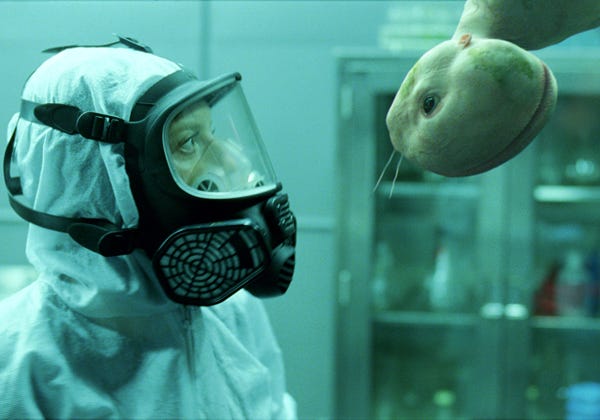Splice

Vincenzo Natali’s “Splice” includes a mouth-of-madness moment so jarringly explicit it practically writhes off the screen and wriggles in your lap. Boy howdy, you’ll know it. (No spoilers, but just know that planting a smacker on Halle Berry no longer stands as Adrien Brody’s most unpredictable gesture.)
It might be the most brazenly bizarre post-Oscar scene for a Best Actor winner. It’s definitely the bravest, boldest plot turn of any major 2010 release. Minutes later, “Splice” tops even that, terrifyingly so, in a scene that stifled a preview-screening crowd’s nervous titters. And then there’s the coda.
Like its genetically hybridized human/animal character, “Splice” unleashes one monstrous, unsettling adaptation after another. It’s a jagged needle to the nerves that elevates to a level of severe psychological discomfort that most audiences won’t stand for given a relative lack of traditional terror.
Beginning with amniotic fluid-soaked credits and carried to term through a chilling conclusion, Natali’s cautionary tale coats the nerves with thick midnight-movie mucosa that’s morally sticky, diabolically satirical, ambitiously allegorical, dangerously kinky and skillfully disconcerting.
Brody and Sarah Polley are Clive and Elsa, a romantically linked pair of rock ‘n’ roll geneticists who’ve extracted a revolutionary compound from Fred and Ginger, a pair of synthesized organisms. Clive calls them a “multi-species morphogen.” You’ll call them a cross of a hairless mole and, well, a wriggling penis.
From Fred and Ginger, Clive and Elsa’s pharmaceutical patrons can commodify medicine to vanquish Alzheimer’s, Parkinson’s and the like. Unwilling to be pressed into servitude to drive up stock, both Clive and Elsa are complicit in a choice that comes next — illegally combining human and animal DNA.
The result yields a whiskered, grunting, armless female biped with a seam that bisects its head, far-set eyes, a tail with a stinger and the ability to age years in mere days. Named Dren, the creature is soon introduced to dresses and dolls while undergoing a puberty in which she sprouts wings. To keep their creation quiet, Clive and Elsa move Dren to Elsa’s abandoned childhood country home.
There, things go very wrong. But discussing more would spoil not only “Splice’s” deeply unhinged developments, but the subtext in the script by Natali, Antoinette Terry Bryant and Doug Taylor that exceeds even seasoned horror-fan expectations.
Even when catering to conventional scares, Natali keeps things feverishly hairy — blending Dren’s goopy C-section birth with a grand mal seizure and distressingly unsanitary lab procedures. Later, a mating dance between Fred and Ginger lovingly borrows choreography from David Cronenberg.
He also lets the dynamic of power, principles and ethics shift between Clive and Elsa without overplaying it. After balking at talk of babies, Elsa develops an awfully fierce maternal instinct, while Clive, initially anxious to abort this abomination, slowly warms to Dren as she grows more human. Rather slyly, Brody and Polley are neither too leaden nor too flippant, giving space for reactions of frazzled laughter and gasping surprise.
Creature creators Howard Berger and Greg Nicotero earn major kudos, too, for their work-of-art design on Dren, an instantly iconic critter if ever there was one. Every new scene reveals something new at which to marvel about Dren's body or movements — a mouse’s snout, a bunny’s haunch, a wolfish observation of prey, an ostrich’s feet, a kangaroo’s bounce. It's an imaginative rendering via a combination of visual-effects supervisor Robert Munroe's flawless digital trickery and performances from young Abigail Chu and adult Delphine Chaneac that rise to the difficult challenge of non-verbal curiosity, affection and anger.
As a graduate-level seminar in shocking sci-fi, “Splice” dissects the dangers of creating in our own distorted images, with a speculative scope that’s as intellectually invigorating as it is sickening.
Read Christopher Lloyd's take on Splice here.
